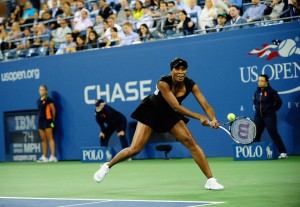The Williams family has not previously been so open about the sisters’ tennis injuries, but I can inform you that the problem Venus Williams is facing today is traceable to at least four years ago, and probably accounts in large part for the steady decline of her play over that period of time.

This dizziness, now identified as Sjogren’s Syndrome, first became evident at the 2007 U.S. Open, where one hour and 42 minutes into a 7-6 (2), 6-4 loss to No. 1 Justine Henin in the semifinals she did something neither she nor Serena rarely do — she called for a trainer.
Henin had just fought back from love-40 to hold serve and stabilize a 4-3 edge in the second set and Williams looked exhausted. You could see her breathing hard on court. There was a look of consternation on her face, like someone who knew there was something wrong but who couldn’t relate it to some normal tennis injury — like a knee or shoulder.
“I’m OK. I was just feeling dizzy, a little sick to the stomach,” Williams said bravely after the defeat. “I’m not sure what’s wrong with me. But, you know, credit to her for playing well.”
After the press briefing, I located mother Oracene in the tunnel leading to the women’s locker room and asked if she was worried enough to urge Venus to get a full workup. “Yes,” she said. “I want her to go to the Mayo Clinic.” Oracene also disclosed that after Wimbledon a few months earlier, Venus had been diagnosed with anemia and had come down with similar dizziness at San Diego a few weeks later, during the start of the U.S. Open Series.
I never found out if Venus went to the Mayo Clinic, but if the best anyone could say is that she was suffering from “anemia,” that wasn’t good enough. Now she knows why she’s anemic. It’s Sjogren’s Syndrome, and she believes it’s treatable and that she’ll be back on the WTA Tour, perhaps this year.
It is a tribute to Williams’ competitiveness that she not only played that match at the Open semifinals four years ago, but finished it.
“Unbelievable courage,” said Henin’s longtime coach, Carlos Rodriguez, who was in rapture not only over his own player but Williams as well. “I’ve never seen Venus play like this in years. I’ve never seen her come to the net so often and so well. With this performance,” Rodriguez declared, “she’s back at the top.”
If only Rodriguez knew that Venus had deeper problems.
After that disturbing experience at Wimbledon, Venus took a month off, possibly to get that complete work-up, then went to the Far East for three small tournaments, winning 12 of 14 matches, though never facing a top-10.
In 2008, she won her last Grand Slam, at Wimbledon, and was 40-11 overall. In 2009 an hend 2010 she won only two tournaments each season — at Dubai and Acapulco. She finished 38-16 in ’09 and 38-7 in ’10.
She was now pushing 30 years of age and her best tennis was behind her, but she was also still fighting flareups of the fatigue that began in 2007. When she pulled out of the U.S. Open this week, it was only her fourth tournament of the year. She is 8-3 for the season without getting past a quarterfinal.
She put on her usual brave face this week at the Open, insisting her career is not over. It may not be, but her championship days are. Between her age and her physical problems, she’s no longer strong enough to win the seven matches required to capture a major.
